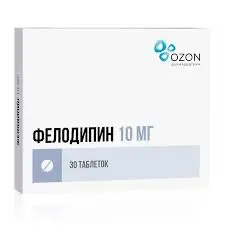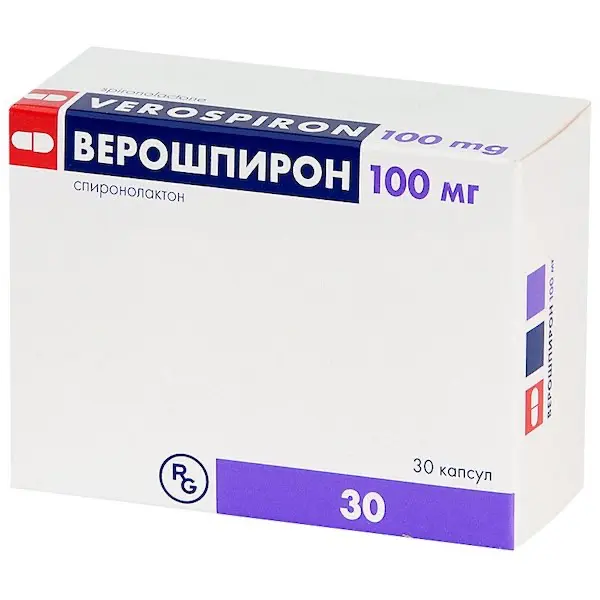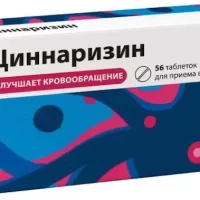Description
Verospilactone Pharmacodynamics
Spironolactone is a potassium-saving diuretic whose action is due to an aldosterone antagonist (mineralocorticosteroid hormone of the adrenal cortex). Aldosterone promotes reverse absorption of sodium ions in the renal tubules and enhances excretion of potassium ions. Spironolactone is a competitive aldosterone antagonist in its effect on the distal parts of the nephron (it competes for binding sites at cytoplasmic protein receptors, reduces the synthesis of permease in aldosterone-dependent section of the collecting tubes and distal tubules), increases excretion of sodium, chlorine and water ions and reduces excretion of potassium ions and urea, reduces urine acidity.
Increased diuresis causes antihypertensive effect, which is not permanent.
Diuretic effect appears on the 2nd-5th day of treatment.
Indications
Essential hypertension (as part of combination therapy).
Edema syndrome in chronic heart failure (can be used in monotherapy and in combination with standard therapy).
Conditions in which secondary hyperaldosteronism may be found, including liver cirrhosis accompanied by ascites and/or edema, nephrotic syndrome, and other conditions accompanied by edema.
Hypokalemia/hypomagnesemia (as an adjunct to its prophylaxis during treatment with diuretics and when other methods of potassium correction are impossible).
Primary hyperaldosteronism (Conn’s syndrome) – for short preoperative treatment.
To establish the diagnosis of primary hyperaldosteronism.
Contraindications
Hypersensitivity to any of the components of the drug.
Addison’s disease.
Hyperkalemia.
Hyponatremia.
Severe renal insufficiency (creatinine clearance less than 10 ml/min).
Anuria.
Concomitant use of eplerenone and other potassium-saving diuretics, potassium preparations.
Diabetes mellitus with confirmed renal failure.
Pregnancy, breast-feeding period.
Childhood under 3 years of age (due to the solid dosage form).
Lactase deficiency, lactose intolerance, glucose-galactose malabsorption syndrome (because the drug contains lactose monohydrate).
With caution:
Hypercalcemia, metabolic acidosis, atrioventricular block (hypercalemia contributes to its enhancement); diabetes mellitus (with confirmed or suspected chronic renal failure); diabetic nephropathy; surgical interventions, during anesthesia; taking drugs that cause gynecomastia; local and general anesthesia; old age; menstrual cycle disorders, enlargement of the breast; liver failure, liver cirrhosis.
Use during pregnancy and during breast-feeding:
The use of the drug Veroshpilactone is contraindicated in pregnancy and during lactation.
Spironolactone and its metabolites may pass through the placental barrier. Spironolactone metabolites are found in breast milk. If it is necessary to use the drug during breast-feeding, breast-feeding should be stopped.
How to use and dosages.
- Inside.
- Essential hypertension.
- The daily dose for adults is usually 50-100 mg once and may be increased to 200 mg, the dose should be increased gradually, once every 2 weeks. To achieve an adequate response to therapy, the drug should be taken for at least 2 weeks. If necessary, dose adjustment is performed.
- Idiopathic hyperaldosteronism
100-400 mg/day is prescribed.
Severe hyperaldosteronism and hypokalemia
Prescribe 300 mg/day (maximum 400 mg/day) in 2-3 doses; if condition improves, the dose is gradually reduced to 25 mg/day. - Hypokalemia and/or hypomagnesemia
In hypokalemia and/or hypomagnesemia caused by diuretic therapy the drug is prescribed at a dose of 25-100 mg/day, once or in several doses. The maximum daily dose is 400 mg if oral potassium preparations or other methods of potassium deficiency supplementation are ineffective. - Diagnosis and treatment of primary hyperaldosteronism
As a diagnostic agent in a short diagnostic test: 400 mg/day for 4 days, distributed in several intakes per day. If blood potassium content increases during drug administration and decreases after drug withdrawal, primary hyperaldosteronism may be suspected.
In long-term diagnostic test: in the same dose for 3-4 weeks. If correction of hypokalemia and arterial hypertension is achieved, the presence of primary hyperaldosteronism can be assumed. - A short course of preoperative therapy for primary hyperaldosteronism
Once the diagnosis of hyperaldosteronism has been established by more definitive diagnostic methods, Veroshpilactone should be taken at 100-400 mg/day, divided into 1-4 doses per day for the duration of preparation for surgical intervention. If surgical intervention is not indicated, the drug Veroshpilactone is used for long-term maintenance therapy, using the lowest effective dose that is chosen individually for each patient. - Edema against a background of nephrotic syndrome
Daily dose for adults is usually 100-200 mg/day. Spironolactone has not been found to affect the underlying pathological process, and therefore the use of this drug is recommended only when other therapies are ineffective. - Edema syndrome in chronic heart failure
Daily, for 5 days, 100-200 mg/day in 2-3 doses, in combination with “loop” or thiazide diuretic. Depending on the effect, the daily dose is reduced to 25 mg. The maintenance dose is selected individually. Maximum dose is 200 mg/day. Edema in cirrhosis
If urinary sodium to potassium ion ratio (Na+/K+) is greater than 1.0, the daily dose for adults is usually 100 mg. If the ratio is less than 1.0, the daily dose for adults is usually 200-400 mg. The maintenance dose is adjusted individually. - Edema in children.
The initial dose in children over 3 years of age is 1-3.3 mg/kg body weight, or 30-90 mg/m2/day in 1 to 4 doses. After 5 days, the dose is adjusted and if necessary increased by 3 times of the initial dose.





